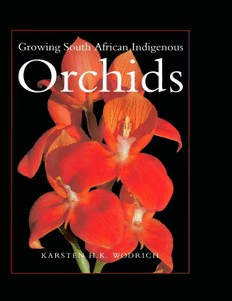
Growing South African indigenous orchids PDF
Preview Growing South African indigenous orchids
GROWING SOUTH AFRICAN INDIGENOUS ORCmDS '. . . ." Northern \ \ '-'-' ' Cape \ \ Map I . Climatic regions and topography of South Africa. Colour map supplied by Dr O.Malan, Stellenbo ch; climatic regions based on information from the South African Weather Bureau, Pretoria; provincial boundaries based on a map published by the Chief Di rectorate of S urvey and Land Information, Department of Regional and Land Affairs, 1994. Dot !lines: climatic region boundaries; olid lines: province boundaries; bullets: towns and cilie ; A-L: climatic region identifyers. Growing S outh A frican Indigenous Orchids By KARSTEN H . K .WODRICH Gordon's B ay, South A frica A.A. BALKEMA IROTIERDAM/BROOKFIELDI 1 997 Authorization to photocopy items for internal o r personal use, or the internal o r personal use o f specific clients, is granted by A.A.Ba1kema, Rotterdam, provided that t he base fee of U S$1.50 per c opy, plus US$O.lO per page is paid directly to Copyright Clearance Center, 222 Rosewood Drive, Danvers, MA 01923, U SA. For those organizations that have been granted a photocopy license by CCC, a separate system o f payment has b een a rranged. T he fee c ode f or u sers o f the Transactional Reporting S ervice i s: 90 5 4106506197 U S$1.50+ U S$O.10. Published b y A.A. B a1kema, P.O. B ox 1675, 3 000 BR R otterdam, Netherlands Fax: +31.1 0.4135947; E-mail: [email protected]; Internet site: http://www.ba1kema.n1 A.A. Ba1kema Publishers, Old Post Road, Brookfield, v r 05036-9704, USA Fax: 802.276.3837; E -mail: [email protected] ISBN 9 0 5 410 6 50 6 © 1997 A .A.Balkema, R otterdam Printed i n t he N etherlands To Mom, Dad, Anke, Mariusz and V incent VII Preface This comprehensive guide was born out o f t he frustration experienced in trying to obtain i nformation o n the cultivation o f indigenous orchids. Although m any e xcel lent a rticles on o rchid c ultivation h ave been p ublished in the South A frican Orchid Journal, in Orchids (formerly the American Orchid S ociety Bulletin) and in other national and international publications, there is still no single comprehensive guide available. The help of n umerous dedicated growers, who shared their expe riences and provided me with detailed notes on cultivation, has enabled me to compile this guide to the propagation and cultivation of i ndigenous epiphytic and terrestrial o rchids. Increased land usage and particularly wetland drainage for city expansion, agri culture and rural settlements have infringed on the natural habitats of m any plant species with serious consequences for natural populations. Within the next few decades South Africa may reach the land usage percentage that some European countries have now. The r isk o f extinction of l ocal populations and s pecies is very real. Because of t his, successful propagation of w ild orchids should be apriority. As plants grown from seed and from vegetative divisions and tissue culture become available, pressure exerted on natural populations by over-collection will de crease. In some instances it will be t he only means of t he species' survival where the natural habitat n o l onger e xists. The guide is a culmination of e ight years of 'putting things together' and has been a rewarding learning experience in a process that d oes not e nd with the pub lication of t his book. The world of o rchid growing is changing constantly; new cultivation methods are tried by growers as is the experimentation w ith new and different seed g ermination and tissue culture media. Together with this there have been changes in the classification of o rchid species in the recent years and new species are regularly being added to the impressive list o f o rchid species found in South A frica.
